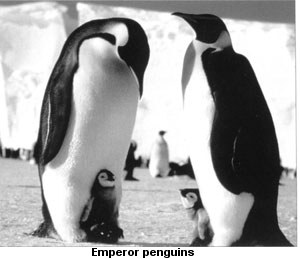
| Glasgow Digital Library | Voyage of the Scotia | BRUCE | PEOPLE | SHIP | ANTARCTIC | INDEX |
|---|

Most of the vegetation of the Antarctic continent consists of mosses and lichens. Lichens have been found on rocks within 480km (300 miles) of the South Pole. A few primitive species of grasses and only two flowering plants are found on the Antarctic Peninsula.
Animals cannot survive the extremely cold temperatures of the Antarctic winter and the only ones to overwinter on the ice are the emperor penguin and the Weddell seal. The rest swim or fly to warmer latitudes.
In summer the melting ice and upwelling water bring nutrients to the surface resulting in a big increase of phytoplankton (plant plankton).
Zooplankton (animal plankton) lives off the phytoplankton. The largest of these is the shrimp-like creature called krill.
Krill is the main diet of penguins, many other visiting sea birds, seals (56% of the world's seals live in Antarctica) and whales. A swarm of krill seen off Elephant Island in the South Shetland Islands was estimated to weigh 2.5 million tonnes. A blue whale can consume four tonnes of krill in a day.

During the summer the Antarctic is one of the most productive sea areas in the world. The life in the ocean resulted in the first interest in the Antarctic by whalers and sealers as well as by today's fishing boats.
Some birds of the Antarctic
Penguins - Adelaide, gentoo, chinstrap, macaroni, king, emperor
Other birds - skuas, snowy petrels, Wilson's petrels, Antarctic terns, Arctic terns (in summer), albatross
| Glasgow Digital Library | Voyage of the Scotia | BRUCE | PEOPLE | SHIP | ANTARCTIC | INDEX |
|---|